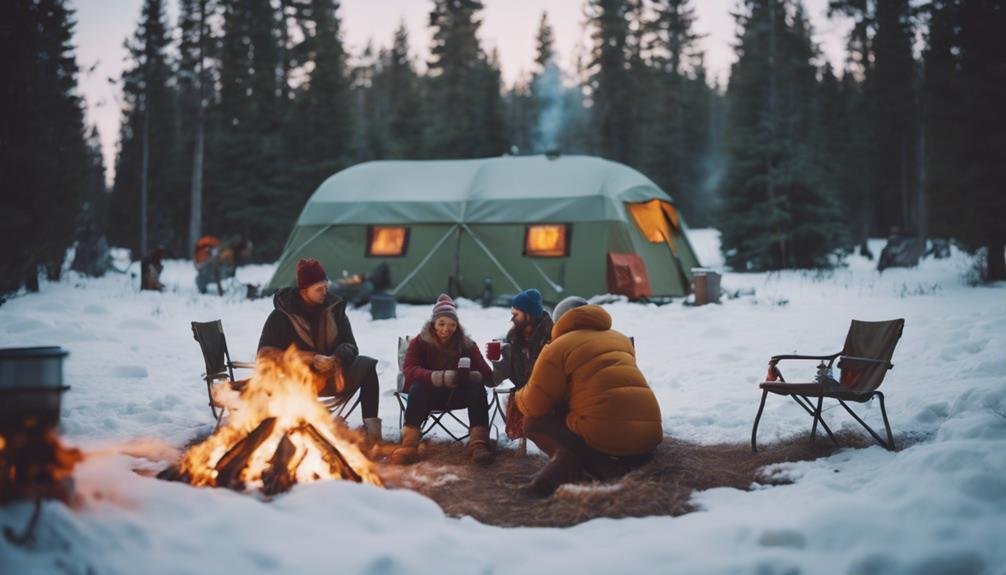
Winter camping's an adventure, but I've learned staying warm is key. I always choose a four-season tent that fits my gear without letting in drafts. Insulating my sleeping area with a thick pad and adding extra blankets keeps me cozy at night. Layering my clothing with moisture-wicking baselayers, warm mid-layers, and a windproof outer shell works wonders against the chilly air. Packing nutrient-rich meals and hot drinks fuels my body, while keeping gear dry is a must. If I'm attentive to the signs of cold-related hazards, I feel secure. There's so much to explore, and I can't wait to share more tips!
Key Takeaways
- Choose a four-season tent with proper ventilation to withstand harsh winter conditions and minimize drafts.
- Layer clothing with moisture-wicking base layers, insulating mid-layers, and waterproof outer layers to retain warmth.
- Use an insulated sleeping pad and a well-rated sleeping bag to provide necessary warmth while sleeping.
- Stay hydrated with warm beverages and nutritious foods to maintain energy levels and body temperature.
Choose the Right Tent
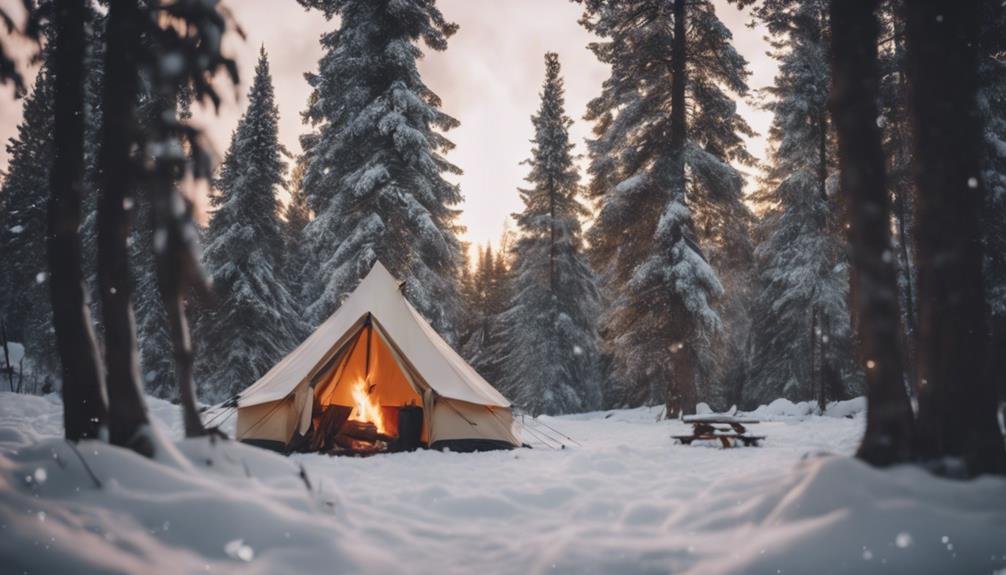
When I gear up for winter camping, choosing the right tent is crucial to ensure warmth and protection against the harsh elements. I always consider the tent size carefully; it needs to be spacious enough to accommodate my gear, but not so large that it becomes a heat trap. A snug fit helps retain warmth, while a tent that's too big can lead to drafts and chill. I often opt for a four-season tent, designed to withstand heavy snowfall and strong winds, ensuring I'm safe and secure.
Ventilation is another key factor I can't overlook. In winter, condensation can become a real issue, so I pay attention to the tent's ventilation needs. I look for tents with adjustable vents that allow moisture to escape without letting in too much cold air. This balance keeps the inside comfy and dry, which is vital for a good night's sleep.
With the right tent, I can embrace the freedom of winter camping, knowing I've a cozy sanctuary waiting for me after a day of adventure. Plus, being well-prepared makes every trip more enjoyable!
Insulate Your Sleeping Area

Insulating my sleeping area is essential for a warm and restful night in the frigid winter landscape. I've learned that taking a few extra steps can make all the difference between a cozy night and a cold, restless one.
Use an Insulated Sleeping Pad: This acts as a barrier between me and the cold ground, helping to insulate ground heat loss.
Add Extra Blankets: I always pack my favorite thermal blankets to layer on top of my sleeping bag for added warmth.
Insulate the Entrance: I use a tarp or extra fabric to cover the entrance of my tent, preventing cold drafts from sneaking in.
Choose the Right Location: I scout for a sheltered spot, like near trees or hills, to minimize exposure to harsh winds.
Layer Your Clothing

When I gear up for winter camping, I always focus on layering my clothing effectively. Choosing the right fabrics, adding insulating mid-layers, and remembering essential accessories are key to staying warm and comfortable in the cold.
Each layer plays a crucial role in regulating my body temperature and protecting me from the elements.
Choose Appropriate Fabrics
Choosing the right fabrics for layering my clothing can make all the difference in staying warm and comfortable during winter camping adventures. I've learned that not all fabrics are created equal, and opting for the right materials can keep me cozy while allowing me the freedom to move.
Moisture Wicking Fabrics: I always start with a base layer made of moisture-wicking materials. This keeps sweat off my skin, preventing that chilling feeling when temperatures drop.
Breathable Materials: It's essential to choose breathable fabrics for my mid-layer. They let moisture escape while trapping warmth, which is crucial for regulating my body temperature.
Insulating Layers: For my outer layer, I look for windproof and waterproof materials. They shield me from the elements while maintaining warmth.
Natural Fibers: I sometimes opt for wool or fleece, as they provide excellent insulation and warmth even when wet.
Insulate With Mid-Layers
Mid-layers play a crucial role in my winter camping outfit, providing the essential warmth and flexibility I need to stay comfortable in chilly conditions. They act as the insulating barrier between my base layer materials and the outer shell, trapping heat while allowing moisture to escape. When choosing my mid-layers, I prioritize thermal fabric performance, looking for materials that offer both breathability and insulation.
I often opt for fleece or down jackets, which provide a great balance of warmth without adding bulk. These fabrics are lightweight yet incredibly effective at retaining heat, helping me feel cozy even when temperatures drop. Layering these pieces gives me the freedom to adjust my outfit based on fluctuating weather conditions, ensuring I never feel restricted or too hot.
I also appreciate the versatility of mid-layers, which I can easily toss on or take off as needed. This adaptability allows me to fully enjoy the beauty of winter camping, whether I'm hiking to a campsite or relaxing around the fire. With the right mid-layers, I can embrace the cold and truly savor my outdoor adventures.
Don't Forget Accessories
Accessories are essential for winter camping, as they can make a significant difference in comfort and warmth during those frigid nights. I can't stress enough how crucial it's to layer your clothing effectively.
Glove Selection: I opt for a pair of insulated gloves along with some thin liners. This combo keeps my fingers warm while allowing for dexterity when setting up camp.
Face Protection: A good balaclava or face mask is a must. It shields my face from biting winds and prevents frostbite during those long, chilly evenings.
Warm Socks: I always bring multiple pairs of thick, moisture-wicking socks. Cold feet can ruin a camping trip, so I keep them dry and cozy.
Beanie or Hat: Since a lot of body heat escapes through the head, I pack a snug beanie to trap warmth.
Select a Quality Sleeping Bag

When I'm choosing a sleeping bag for winter camping, I always pay close attention to the temperature rating; it can make or break my night's sleep.
I also consider the insulation materials, as they play a crucial role in keeping me warm and comfortable.
Finding the right combination of these factors has made all the difference on those chilly nights under the stars.
Temperature Rating Importance
Choosing a sleeping bag with the right temperature rating is essential for staying warm and comfortable during winter camping adventures. I've learned that understanding the sleeping bag temperature rating can make all the difference between a restful night and a chilly wake-up call.
Know Your Comfort Level: Everyone has different warmth needs. Identify what temperature you'll be camping in and choose a bag rated for slightly below that.
Check the Rating: Look for bags with a lower limit rating; this tells you how low the temperature can drop while still keeping you warm.
Consider Insulation Performance: Remember that insulation performance in cold temperatures can vary. Don't solely rely on the rating; research the materials and construction of the bag.
Layering Matters: Sometimes, combining your sleeping bag with a liner can enhance warmth, so think about your overall sleep system.
With the right sleeping bag temperature rating, I've enjoyed many cozy nights under the stars, free from the biting chill of winter. Make the right choice, and you'll embrace the freedom of winter camping without fear of the cold!
Insulation Material Types
Understanding the different insulation materials in sleeping bags is crucial for finding one that keeps me warm and comfortable during those frigid winter nights. When it comes to insulation, I often weigh the benefits of down insulation against synthetic insulation.
Down insulation is renowned for its incredible warmth-to-weight ratio. It's fluffy, lightweight, and compresses easily, making it a favorite for backpackers like me who crave freedom on the trail. However, I've learned that it loses its insulating properties when wet, so keeping it dry is essential.
On the other hand, synthetic insulation offers reliability in damp conditions. It's less expensive and retains warmth even when wet, which is reassuring during unexpected storms. While it may be bulkier than down, I appreciate the peace of mind it provides, especially when the weather turns unpredictable.
Ultimately, my choice often depends on the specific conditions I'll face. If I'm heading into a dry, cold environment, I might lean toward down for the lightweight advantage. But for wet conditions, synthetic insulation becomes my go-to. Finding the right balance helps me enjoy the freedom of winter camping without the chill.
Keep Your Gear Dry
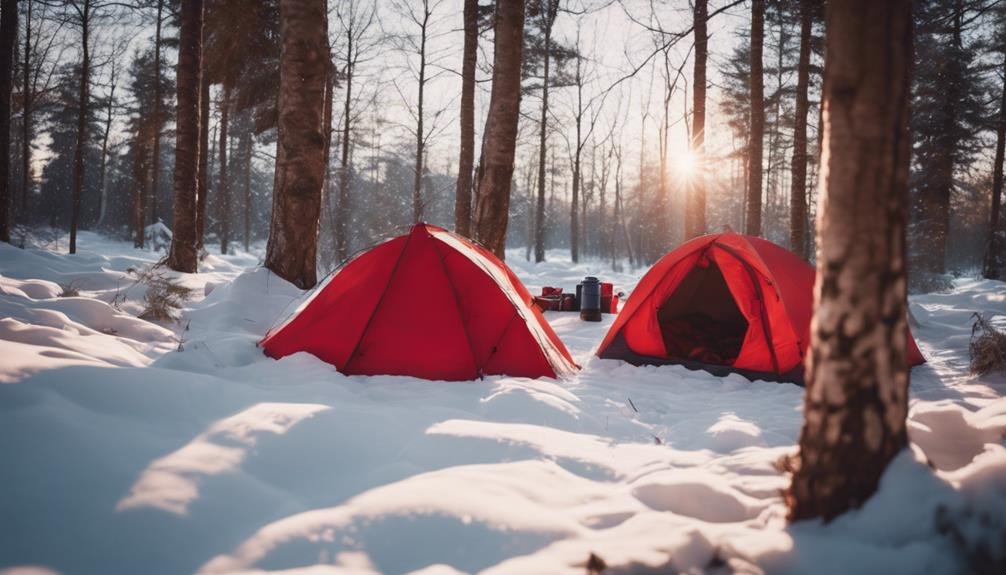
Keeping my gear dry is essential for a comfortable winter camping experience, as moisture can quickly turn a cozy adventure into a cold nightmare. I've learned the importance of wet weather protection firsthand, and I prioritize using weatherproof gear to keep everything dry.
Invest in Quality Gear: I always choose tents, backpacks, and tarps that are specifically designed to be waterproof. This investment pays off when the weather turns nasty.
Use Dry Bags: I pack my clothes and sleeping gear in dry bags. This way, even if my backpack gets soaked, my essentials remain dry and warm.
Elevate Your Gear: When setting up camp, I make sure to keep my gear off the ground. I use a tarp or rocks to create a barrier against melting snow or dampness.
Seal Everything: I double-check all zippers and seams on my gear for any gaps. A little bit of sealant can go a long way in preventing leaks.
Use Heat Sources Wisely
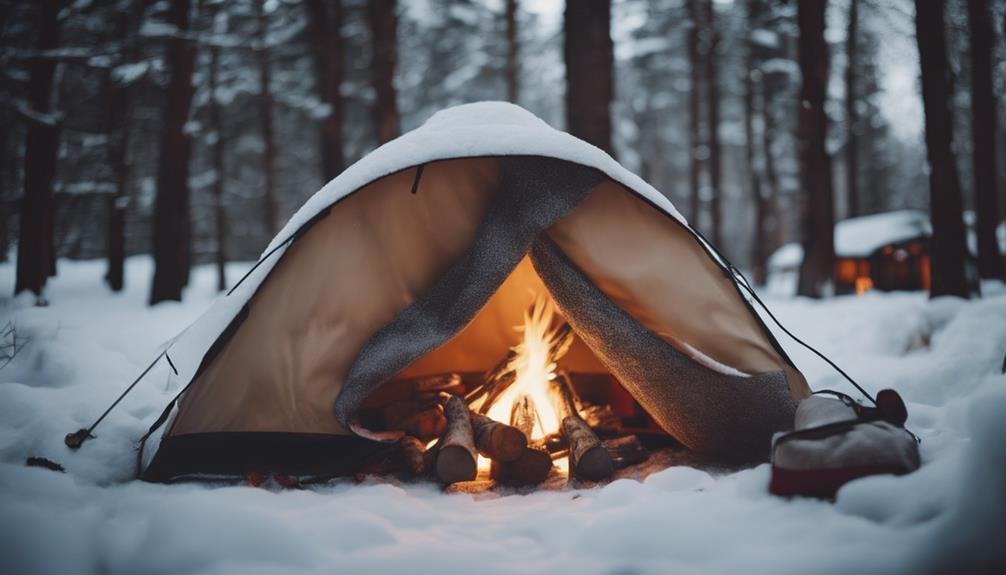
When I camp in winter, using heat sources wisely is crucial for staying warm and safe. Choosing the right portable heaters, investing in insulated sleeping gear, and practicing safe fire techniques can make all the difference.
Let's explore how to maximize warmth while minimizing risks in the chilly outdoors.
Choosing Portable Heaters
Choosing the right portable heater can make all the difference in staying warm and comfortable during a winter camping adventure. I've learned that there are several portable heater fuel types to consider, each with its unique benefits and drawbacks.
To help you choose wisely, here are a few key factors I keep in mind:
- Fuel Type: Whether it's propane, butane, or electric, each has its pros and cons. I prefer propane for its efficiency.
- Size and Weight: I look for a heater that's compact and lightweight, making it easy to transport without sacrificing heat output.
- Heat Output: It's important to choose a heater that fits your space. I make sure to check BTUs to ensure I'll stay warm.
- Safety Features: Always consider portable heater safety considerations. Look for features like tip-over protection and oxygen depletion sensors to keep things safe.
Insulated Sleeping Gear
After selecting a reliable portable heater, the next step is to ensure that my sleeping gear effectively retains warmth throughout the night. I'm all about maximizing comfort, so I invest in insulated sleeping bags that feature breathable insulation. This type of insulation traps warmth without causing me to overheat. I want to feel cozy, not clammy!
To enhance my sleep experience, I always prioritize moisture-wicking fabrics, too. These materials pull sweat away from my body, keeping me dry and comfortable even in the coldest conditions. I've learned that a damp sleeping bag can ruin a night's rest, so I make sure my gear is designed to manage moisture effectively.
Layering is another crucial aspect. I often use a lightweight thermal liner inside my sleeping bag for added warmth without bulk. When I crawl in, I feel like I'm enveloped in a warm cocoon, ready to drift off under the starry sky. By combining high-quality insulated gear and smart layering, I'm able to embrace the freedom of winter camping while staying snug and warm throughout the night.
Safe Fire Practices
While I revel in the warmth of a crackling fire, I always prioritize safety by ensuring it's built in a designated area away from flammable materials. There's nothing like the glow of flames on a cold winter night, but campfire safety is crucial for a successful experience.
Choose the Right Spot: I always pick a clear area, at least 10 feet away from tents, trees, and brush.
Use Dry Firewood: I ensure my firewood is dry and seasoned; it burns better and produces less smoke.
Build a Fire Ring: I create a fire ring with stones to contain the flames and protect the ground.
Extinguish Properly: When I'm done, I always douse the fire with water, stirring the ashes to ensure everything's cold to the touch.
Prepare Warm Meals
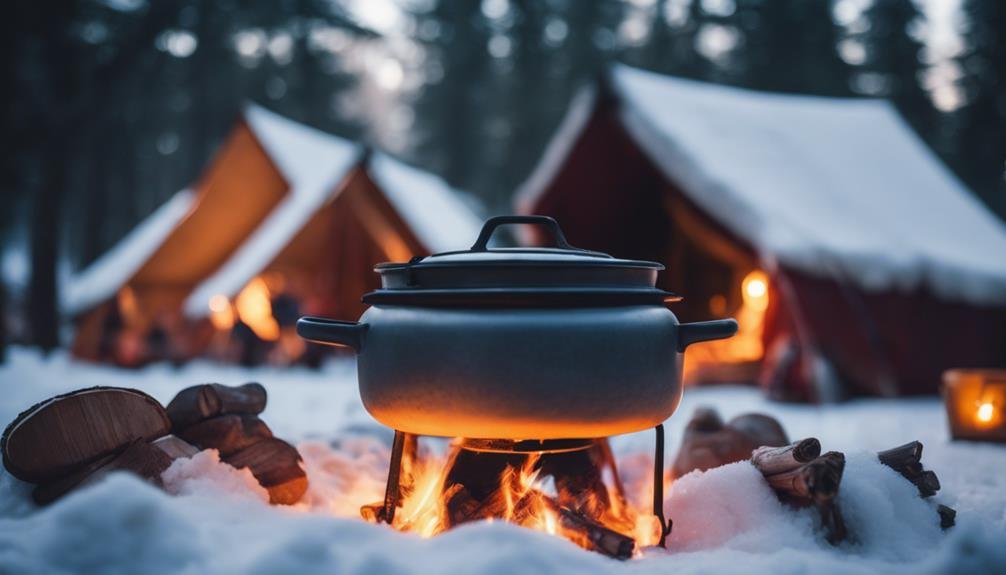
To keep my spirits high in the chill of winter, I always plan to prepare hearty, warm meals that not only nourish my body but also bring a sense of comfort to my campsite.
There's something magical about gathering around a stove, the flicker of firelight casting shadows as I cook hot meals that fill the air with tantalizing aromas.
I start by packing nutrient-dense foods like quinoa, beans, and vibrant vegetables, ensuring I've the energy for my winter adventures.
I love whipping up a steaming pot of chili or a rich, savory stew. These dishes not only warm me up but also offer a satisfying blend of flavors and textures.
I often bring along spices like cumin and paprika to elevate my meals, making each bite a cozy experience.
When I'm out in the wild, I appreciate the simplicity of cooking. A compact camp stove makes it easy to create delicious meals, even in the frost.
As I savor each mouthful, I feel a deep connection to the outdoors, embracing the freedom that comes with winter camping and good food.
Stay Hydrated
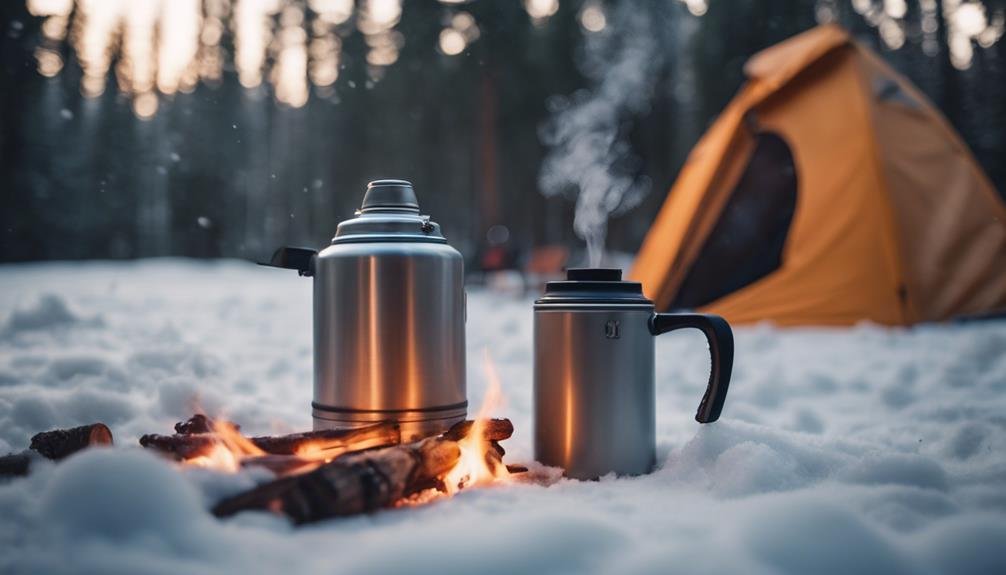
Staying hydrated in the winter wilderness is just as crucial as keeping warm, and I make it a priority to drink plenty of water throughout the day, even when I don't feel thirsty. The cold can mask feelings of dehydration, so I remind myself to drink frequently to maintain hydration levels.
Carry a Water Bottle: I always keep a reliable, insulated water bottle with me. This helps prevent my water from freezing and makes it easy to sip throughout the day.
Warm Up My Water: Sometimes, I heat water over the camp stove and store it in my bottle. It's comforting and encourages me to drink more.
Add Electrolytes: I mix in electrolyte tablets or powder to enhance the flavor and replenish minerals I might lose through sweat.
Set Reminders: I set a timer on my phone or use a watch to remind me to drink every hour—this keeps me on track without having to think about it.
Plan for Shorter Days
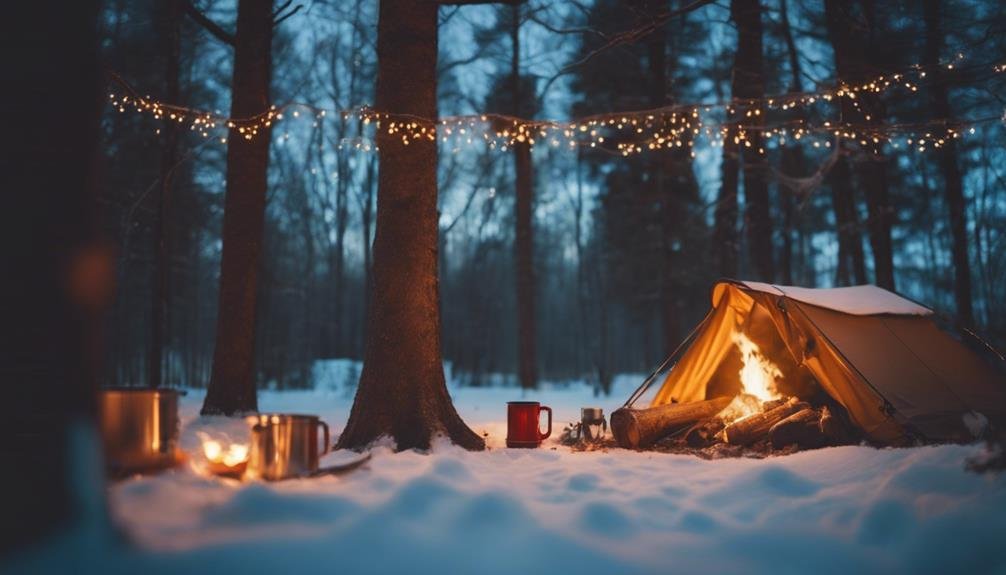
Planning for shorter days is essential when winter camping, as the limited daylight hours can quickly catch you off guard and disrupt your outdoor activities. I've learned to adjust daylight hours in my itinerary, ensuring I make the most of the precious sunlight. This means getting up early and starting my hikes or outdoor adventures at first light.
I always check the sunset timing before heading out, so I know how much time I've before darkness falls. It's crucial to plan my return accordingly, allowing myself ample time to navigate back to camp safely. There's something magical about winter evenings, but I've experienced the chill of being caught outside after dusk, and it's not something I want to repeat.
Moreover, I've found that setting up camp well before sunset not only gives me time to relax but also helps me enjoy the twilight glow. I can stoke the fire, prepare a warm meal, and soak in the serene beauty of the winter landscape. By managing my time wisely, I embrace the freedom of winter camping while staying safe and cozy.
Know the Signs of Hypothermia
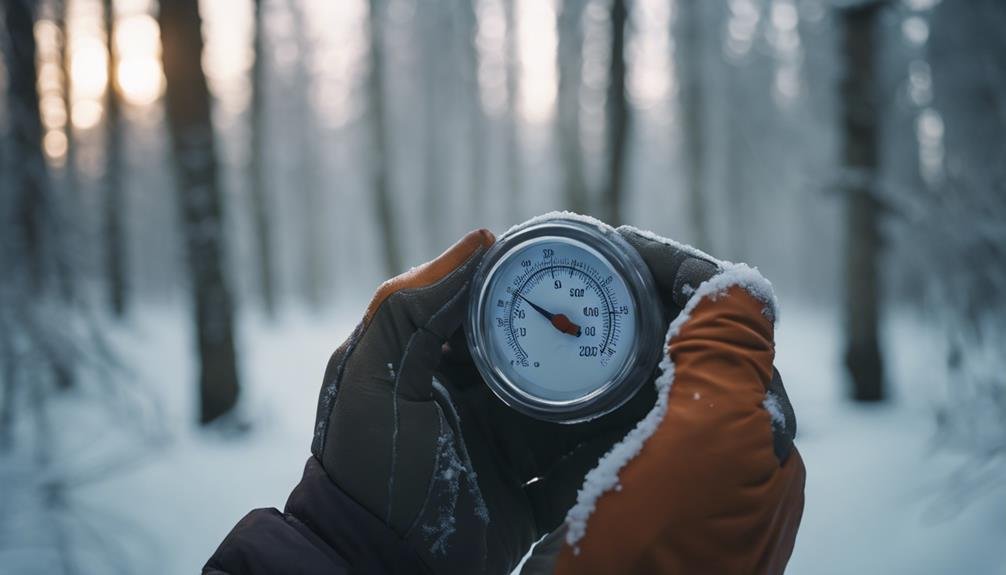
As I embrace the beauty of winter evenings, I also stay alert to the signs of hypothermia, a condition that can creep up on even the most seasoned campers when temperatures drop. It's crucial to identify early hypothermia symptoms so I can act quickly.
Monitoring my core body temperature is essential, and I keep an eye out for these key indicators:
- Shivering: A natural response, but persistent shivering signals I need warmth.
- Confusion: If I start feeling disoriented or have trouble concentrating, it's time to check my gear and body heat.
- Slurred Speech: If my words start to sound jumbled, I know I'm in trouble and need to warm up.
- Fatigue: An overwhelming tiredness can signal that my body's struggling to stay warm.
Recognizing these signs means I can take action before hypothermia becomes severe. I always carry extra layers and hot drinks to keep myself warm and alert. Winter camping offers freedom and adventure, but being aware of these symptoms ensures I stay safe while enjoying the great outdoors.
Conclusion
As I gear up for my winter camping adventures, I remember that 'There's no such thing as bad weather, only bad preparation.'
Staying warm and cozy in the cold requires a thoughtful approach, from choosing the right tent to ensuring my gear stays dry.
By layering my clothing and preparing warm meals, I'm ready to embrace the chilly nights.
With these tips in mind, I can enjoy the beauty of winter while staying comfortable and safe in the great outdoors.
